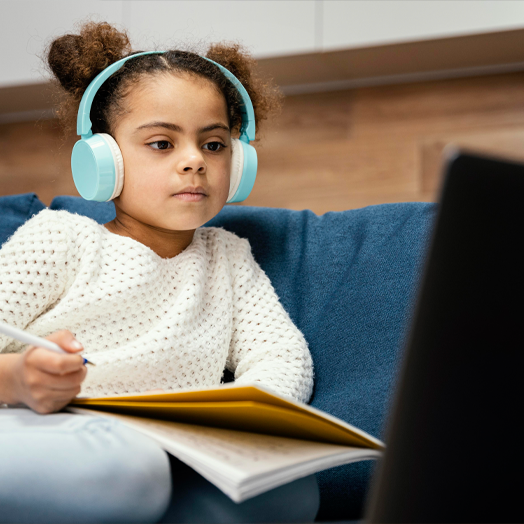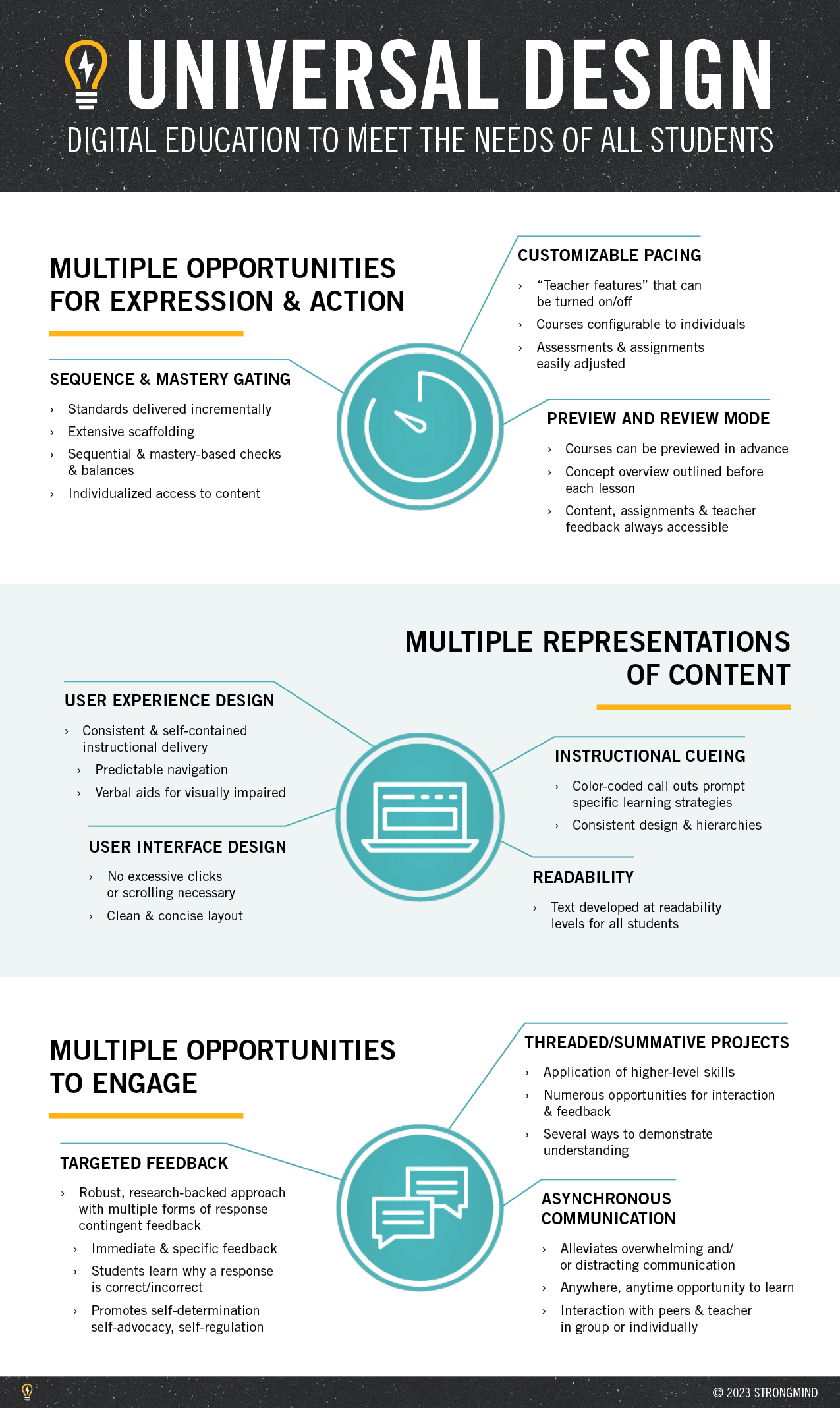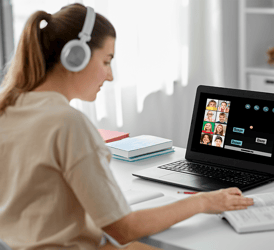Keys to Success for K-5 Digital Learning
Online, Hybrid, and Blended
The pandemic disrupted traditional face-to-face instruction and further accelerated the adoption of digital learning models (online, hybrid, and blended learning). Emergency remote learning emerged to bridge the gap out of necessity, though the quality was inconsistent. Best practices do exist in digital learning, however, based on the 20+ years of experience of schools and course providers. These best practices vary based on implementation factors such as the types of students being served, school location, and other implementation factors. In particular, key differences exist between serving high school students and working with elementary school students. Some of these include the ways in which elementary digital learning leans on:
- A greater emphasis on teacher-led instruction and direct guidance; younger students require more structured and scaffolded learning experiences to develop fundamental skills.
- A variety of interactive and engaging activities that cater to the developmental needs of younger students, including games, manipulatives, hands-on play, and group activities.
- More formative and informal assessments, such as teacher observations, checklists, and short quizzes using simple emoticons, star ratings, etc.
- Extensive parental involvement which is naturally more hands-on, requiring parents to provide direct support and guidance to younger students, like accessing and facilitating activities, monitoring progress, and assisting with technology.


These differing elements of elementary digital learning suggest that, at these grade levels, strategies for creating engaging and effective quality online and blended learning are somewhat different than for older students. This paper explores these strategies, including pedagogy, SEL, kid-friendly platforms, and teacher support.
Implement Effective Pedagogy
Engaging young learners in digital learning environments requires K–5 teachers to adopt a pedagogy that is specifically designed to meet the developmental needs and interests of young children. A few ways to organize chaos in a typical elementary online or hybrid classroom include:
- Allow the natural activities of play by designing play-based learning activities that allow children to explore, imagine, create, and engage in hands-on experiences, e.g., educational apps that incorporate interactive games or simulations to reinforce concepts learned during real-time or face-to-face instruction.
- Ensure that students engage in various sensory experiences, including videos, animations, and colorful visuals to capture children's attention and make learning materials more appealing.
- Use digital tools, such as adaptive learning platforms or interactive software, to provide individualized content to each child. Differentiated instruction recognizes that students have varying backgrounds, interests, preferences, and readiness levels, and acknowledges that students learn at different paces and have different levels of prior knowledge and skills. By providing choice and autonomy in their learning, students feel empowered and become more invested in the educational process.
- Provide opportunities for children to engage with their peers through group projects, play conversations, and cooperative learning activities. Encourage children to share their ideas and learn from one another in informal ways.
- Incorporate movement breaks, brain breaks, and physical activities into the schedule to encourage active learning and playtime.
- Recognize the importance of family involvement in their child’s learning journey. Allow parents to play an active role in supporting their child's learning experience and provide orientation and training for them. Provide guidelines on how to support learning at home and offline activities that align with online content and instruction. Help caregivers to collaborate with the teacher to understand expectations and help their child engage in home-based activities, such as reading to their child or practicing specific skills.
- Provide access to a comprehensive curriculum and a rich array of resources that helps teachers plan and deliver high-quality lessons.
- Employ a variety of assessment strategies to monitor each child's progress and inform targeted individual and small-group instruction. Use both formative and summative assessments, such as online quizzes, observations, and digital backpacks, to gather evidence of learning.
Effective pedagogy is the foundation for digital learning experiences. The pedagogical approach directly influences how students engage with the content, develop skills, and achieve learning outcomes. By adapting content and instructional strategies to meet students at their level, effective pedagogy supports individualized learning experiences and promotes academic growth. Young learners thrive in environments that offer opportunities for social interaction, peer collaboration, and cooperative learning; this is especially true in online and hybrid learning environments. Digital pedagogy attends to students' socio-emotional needs, providing opportunities for self-reflection, empathy-building, and the development of essential life skills.
Envision as an example, a station rotation instructional model in a kindergarten classroom where:
- Students engage in sensory-based activities, games, and projects to develop critical thinking and problem-solving skills, online and offline.
- Teachers provide targeted instruction with small groups of students to provide personalized support and address specific needs, based on data from online assignments or assessments.
- Students use educational software, websites, and apps to practice foundational skills like reading, math, and handwriting. These platforms provide interactive and engaging content.
- Students work together on group projects that promote teamwork, communication, and creativity. They use digital tools to collaborate, share ideas, and create presentations.
- Students go home and parents help to bridge the gap between the classroom and at-home learning support, by accessing their students’ assignments and progress.
Prioritize the Social-Emotional Well-Being of Students
The transition to virtual learning environments can present unique challenges for students, including feelings of isolation, increased screen time, and limited social interactions. Poorly implemented online learning can sometimes feel impersonal, and young students may struggle with a sense of disconnect, stress, anxiety, and other emotional challenges. Prioritizing social-emotional well-being involves creating a supportive and nurturing environment where students feel valued, cared for, and understood.
Teachers play a crucial role in modeling these values, creating clear expectations and a safe space where students feel comfortable expressing their thoughts and ideas without fear of judgment. By engaging students in collaborative projects, group activities, and peer feedback, teachers promote cooperation, active participation, and a sense of collective responsibility for learning.

An inclusive virtual classroom culture values and celebrates the diversity of students. Teachers should create opportunities to explore different cultures, perspectives, and experiences, fostering an appreciation for diversity. Positive reinforcement and recognition are powerful motivators that contribute to a positive classroom culture.
Select Kid-Friendly Platforms and Tools
Kid-friendly tools are intuitive, accessible, and designed to be easy to navigate for young learners. They have clear interfaces, instructions, and layouts that minimize confusion and maximize engagement. There are clear instructions, visual cues, and a streamlined layout, ensuring that even the youngest students can access their assignments, learning aids, and communication tools with ease. These resources make learning more visually appealing, interactive, and immersive with real-life examples and simulations that make abstract ideas more concrete and easier to comprehend for the youngest learners. As an illustration, a cohesive K-5 technology system usually includes:
- A learning management system — the central hub or platform, designed for young learners with a user-friendly interface for curriculum and assessments with visuals and icons. This provides asynchronous/synchronous centralized access for students, teachers, and families, and real-time progress tracking.
- Educational apps — designed specifically for young students to promote interactivity and engagement to support skill development and reinforce concepts learned in the classroom.
- Digital reading platform — access to a wide range of age-appropriate books and reading materials that can be read, listened to, or read aloud. Some platforms also offer interactive features, such as quizzes and comprehension activities.
- Virtual manipulatives — digital versions of hands-on learning tools, such as blocks, counters, and shapes that help students develop spatial awareness, mathematical concepts, and problem-solving skills.
- Digital portfolio platform — allows students to upload their work and reflect on their achievements and growth over time.
- Video conferencing — tools that enable virtual interactions and live sessions with the teacher and peers. These tools facilitate remote learning and allow for real-time discussions, presentations, and collaboration.
User-friendly platforms and tools prioritize accessibility, ensuring that all students, regardless of their abilities or technology proficiency, can effectively engage with the learning materials. These platforms are designed to be compatible with different devices, screen sizes, and assistive technologies, making learning accessible for all learners.
Allocating technology should bridge the digital divide, which reflects the gap in access to technology and the internet among different student populations. Some students may lack access to devices like computers or tablets, or they may not have reliable internet connectivity at home. Addressing this divide is crucial to ensure that all students have equal access to educational resources and opportunities.

Technology platforms include robust data analytics. Even for the youngest students, educators use informal, formative assessments to gain insights into student progress, identify areas for improvement, and make real-time data-driven instructional decisions. Educators can pinpoint specific concepts or skills that students find challenging, allowing teachers to provide targeted interventions or re-teaching strategies to address these gaps effectively. Formative assessments can guide instruction for the youngest students, including the full array of interactive quizzes, digital projects, online discussions, screen sharing and live demonstrations, written assignments, self-assessment and reflection, and off- and online observations and check-ins.
Provide Training and Professional Development for Teachers
Training and professional development for teachers in K-5 blended and online learning is of utmost importance to ensure effective instruction, student engagement, and overall success. Blended and online learning requires teachers to adapt their instructional practices to effectively engage and support students in digital learning environments, including managing a virtual classroom, maintaining student engagement, monitoring student progress, and fostering a positive learning environment. Orientation and training provide teachers with the support to adopt new technology, utilize digital resources, and instill digital citizenship.
Building collaborative communities for sharing best practices is crucial for professional growth, continuous improvement, and fostering innovation in education. When educators come together to share their experiences, strategies, and resources, both teachers and students benefit. Collaborative communities are imperative for educators to engage in professional growth and development. By sharing best practices for primary blended learning, teachers can learn from each other in similar grade or content-specific bands.
StrongMind Understands and Supports these Key Strategies
StrongMind has developed its product and solutions to support the key factors for success in K-5 digital learning.
- We emphasize the development of engaging and interactive content for K-5 students and include multimedia resources, gamified elements, and interactive activities that cater to younger students.
- Through personalized learning pathways, multiple means of assessment, and flexible pacing options, we ensure that students receive instruction and support that aligns with their diverse learning profiles.
- The StrongMind platform provides ongoing assessments and feedback loops to monitor student progress and identify areas for improvement. It incorporates SEL initiatives, providing resources and activities to develop self-awareness, interpersonal skills, and emotional regulation in an environment that promotes a positive and inclusive virtual classroom culture.
- Comprehensive teacher support is offered through the StrongMind platform, including extensive product training, professional development for best practices, ongoing implementation support, and a community experience with other educators. Robust teacher resource guides are also provided with specific resources tailored to each course.
- We understand the importance of support systems for online students that must be robust, adaptable, and inclusive. They must recognize that each student's journey is unique, and provide personalized guidance and resources tailored to their specific needs.
- We recognize the importance of parental involvement in K-5 education and offer features and resources to access real-time progress reports, communication channels with teachers, and resources to support their child's learning at home.
If your school is considering starting, growing, or re-booting your elementary digital learning options, we welcome the opportunity to discuss your goals and plans, and how we may be able to help.


